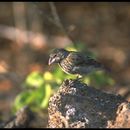Biology
(
الإنجليزية
)
المقدمة من Arkive
The large cactus-finch generally feeds on seeds, arthropods and, as its name suggests, various parts of the prickly pear cactus (Opuntia helleri) (5) (7). During the dry season when competition for food is most intense, it exercises different skills to obtain four main food items. This includes cracking hard Opuntia seeds, extracting seeds from Opuntia fruit and eating the arils, stripping bark to find arthropods, and opening decomposing Opuntia pads to obtain insect larvae (7).
Darwin's finches generally breed opportunistically, with egg-laying being most profuse when rainfall is high and food abundant (2). Pairs are typically monogamous and maintain small territories within which they build a small dome-shaped nest in a bush or cactus. On average each clutch comprises three eggs that are incubated for around 12 days before hatching. The nestlings are mostly raised on insects and leave the nest after about two weeks (4).
During the breeding season, competition for resources between different species of finch can be extremely intense. In promoting ever increasing levels of specialisation, competition for resources has been the driving force behind the evolution of Darwin's finches. This is exemplified by the widely divergent beak sizes of different finch species co-inhabiting one island, compared with much more convergent beak sizes when the same species are isolated from each other on separate islands (4).
Conservation
(
الإنجليزية
)
المقدمة من Arkive
For their unique biological diversity and significance, the Galapagos Islands are designated both a National Park and a World Heritage Site. As a consequence, conservation of the islands' native fauna and flora is a high priority (10). Furthermore,scientists from the Charles Darwin Foundation continue to conduct further research on Darwin's finches in order to ensure their long-term conservation (8).
Description
(
الإنجليزية
)
المقدمة من Arkive
Ever since they were first collected during the voyage of the Beagle, Darwin's finches have inspired a plethora of evolutionary research (3). Descending from an ancestral flock that colonised the Galapagos archipelago several millennia ago, each species famously possesses a beak specialised according to its individual dietary niche (2) (4). The large cactus-finch is one of the most variable of Darwin's finches, with individuals in a single population exhibiting a relatively wide array of beak dimensions (5). Like the other ground finches (Geospiza sp.), the adult male plumage of the large cactus-finch is completely black while the female is brown and streaked (2).
Habitat
(
الإنجليزية
)
المقدمة من Arkive
Occurs mainly in the arid lowland zone (6).
Range
(
الإنجليزية
)
المقدمة من Arkive
The large ground-finch is endemic to the Galapagos where it occurs on the islands of Española and Genovesa (2).
Status
(
الإنجليزية
)
المقدمة من Arkive
Classified as Least Concern (LC) on the IUCN Red List (1).
Threats
(
الإنجليزية
)
المقدمة من Arkive
In common with much of the Galapagos' endemic fauna and flora, Darwin's finches are under threat from habitat destruction, introduced diseases, and invasive predatory species such as rats and cats (8). However, there aren't known to be any substantial threats to the large cactus-finch in particular and its population is thought to be stable (9).

